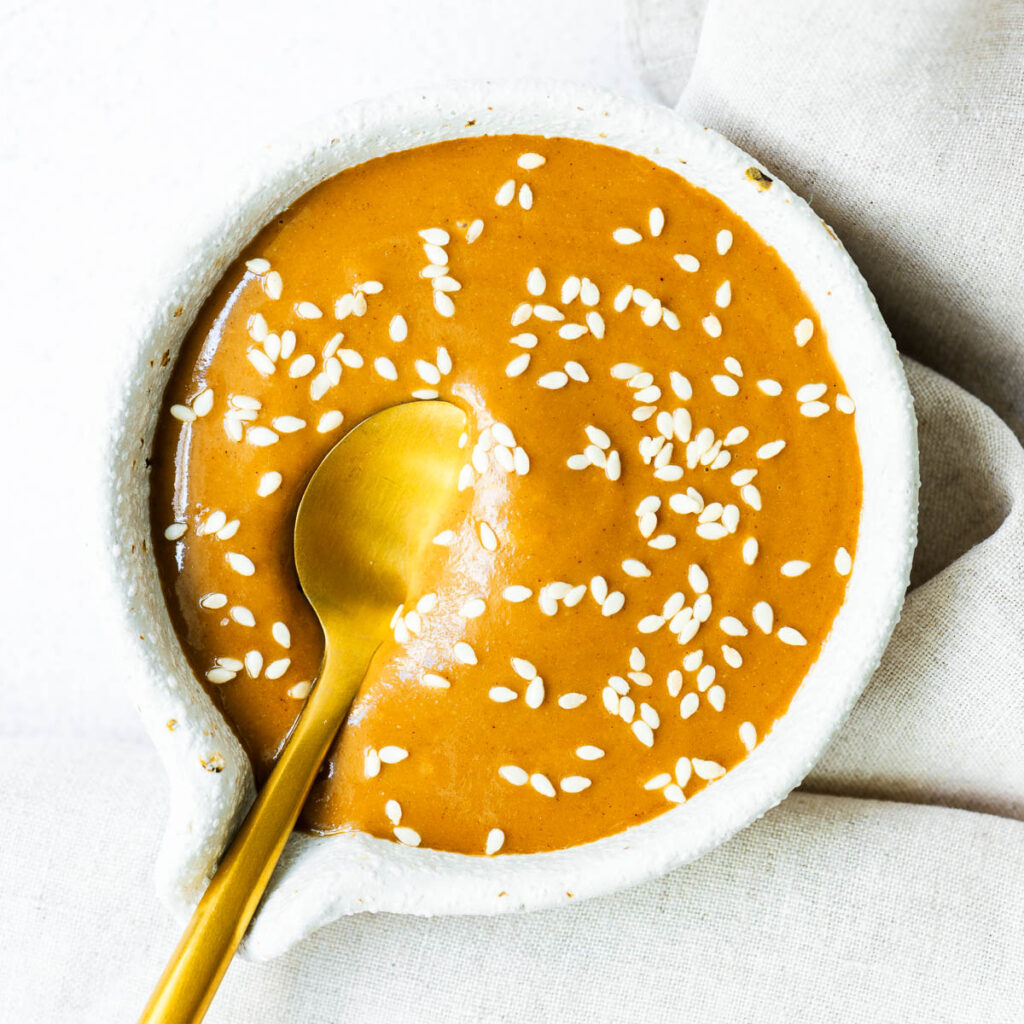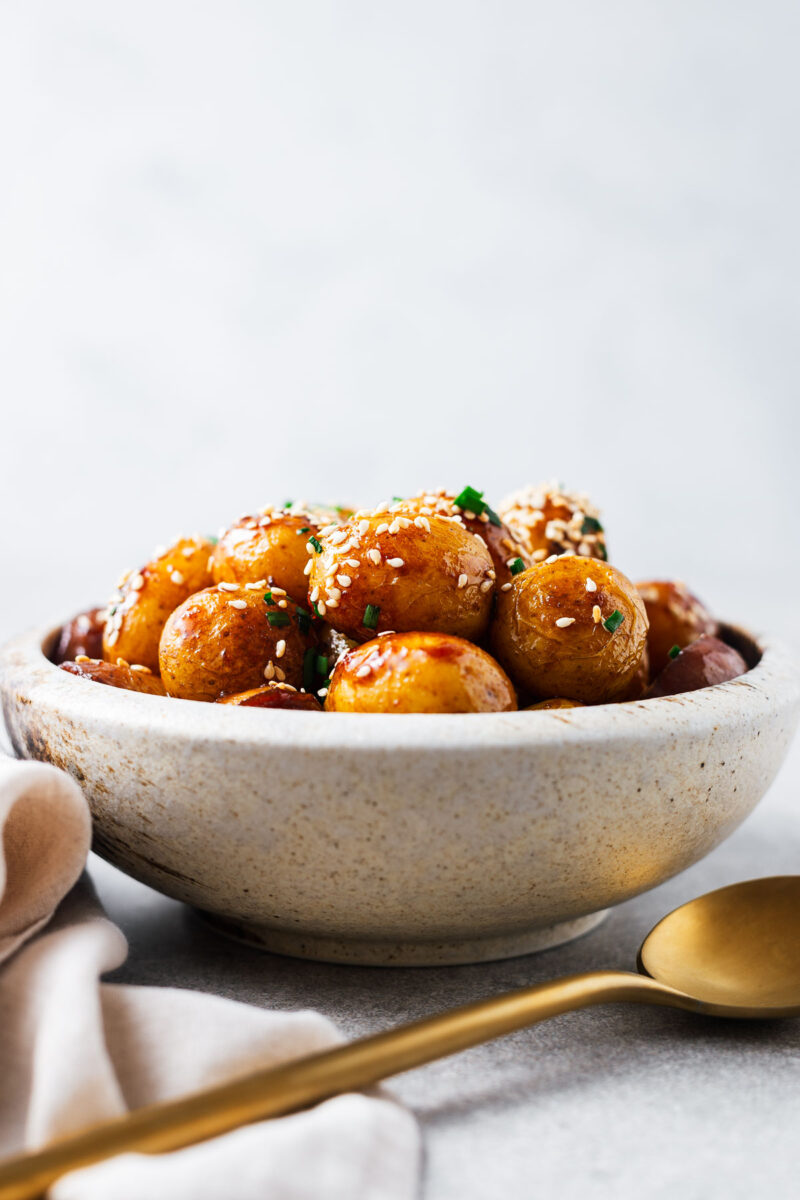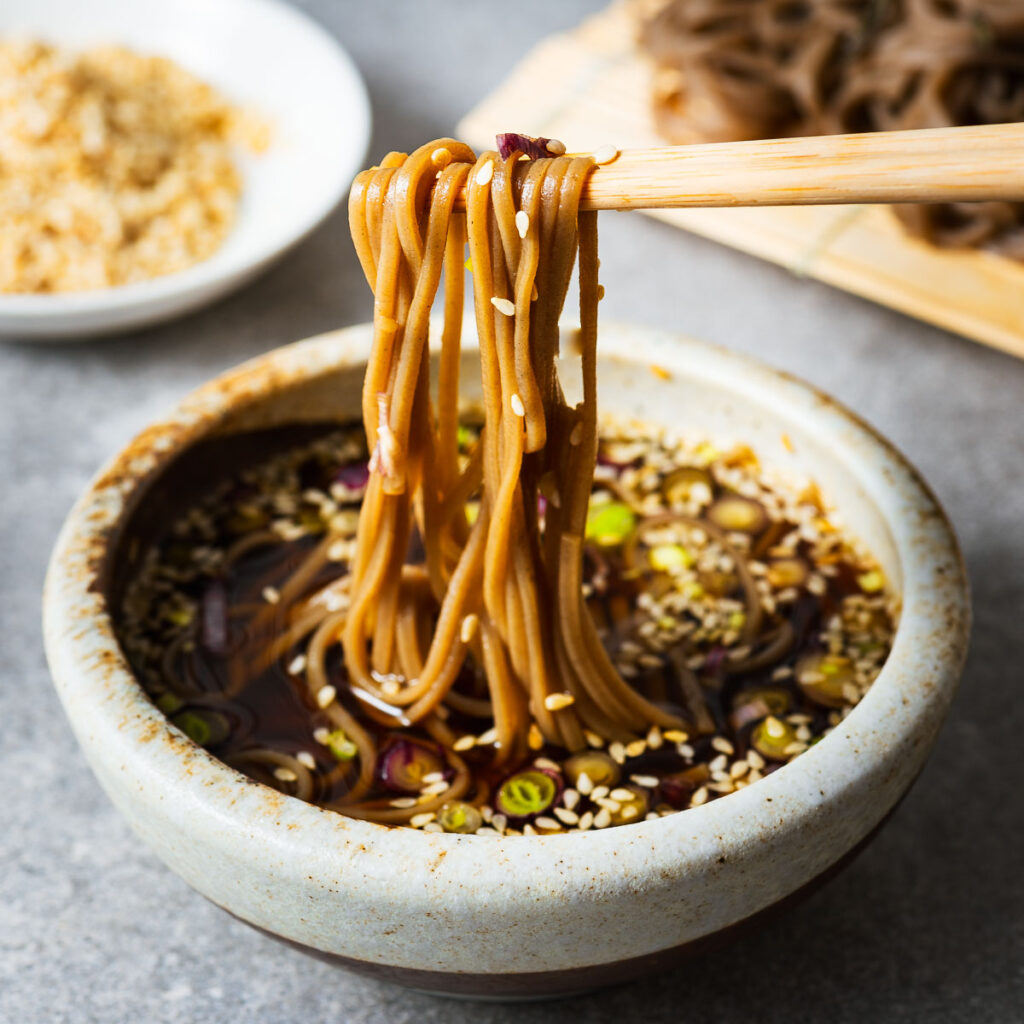How to Toast Sesame Seeds (Oven & Stove Methods)
Learn how to toast sesame seeds for a nutty flavour boost in your dishes. This versatile ingredient complements salads, stir-fries, and baked goods. Follow our simple oven or stovetop method, and store toasted sesame seeds for up to three months!
Learn how to toast sesame seeds for a nutty flavour boost in your dishes. Follow our simple oven or stovetop method, and store toasted sesame seeds for up to three months!
Toasted sesame seeds are a staple in my kitchen. This versatile ingredient adds a nutty flavour and satisfying crunch to everything from salads and stir-fries to baked goods.
And with two methods to choose from, this how-to guide will have you toasting sesame seeds like a pro in no time!
So whether you’re a seasoned cook or just starting out in the kitchen, learning how to toast sesame seeds is a valuable skill to have. Keep reading for step-by-step instructions and tips to achieve perfectly toasted sesame seeds every time.
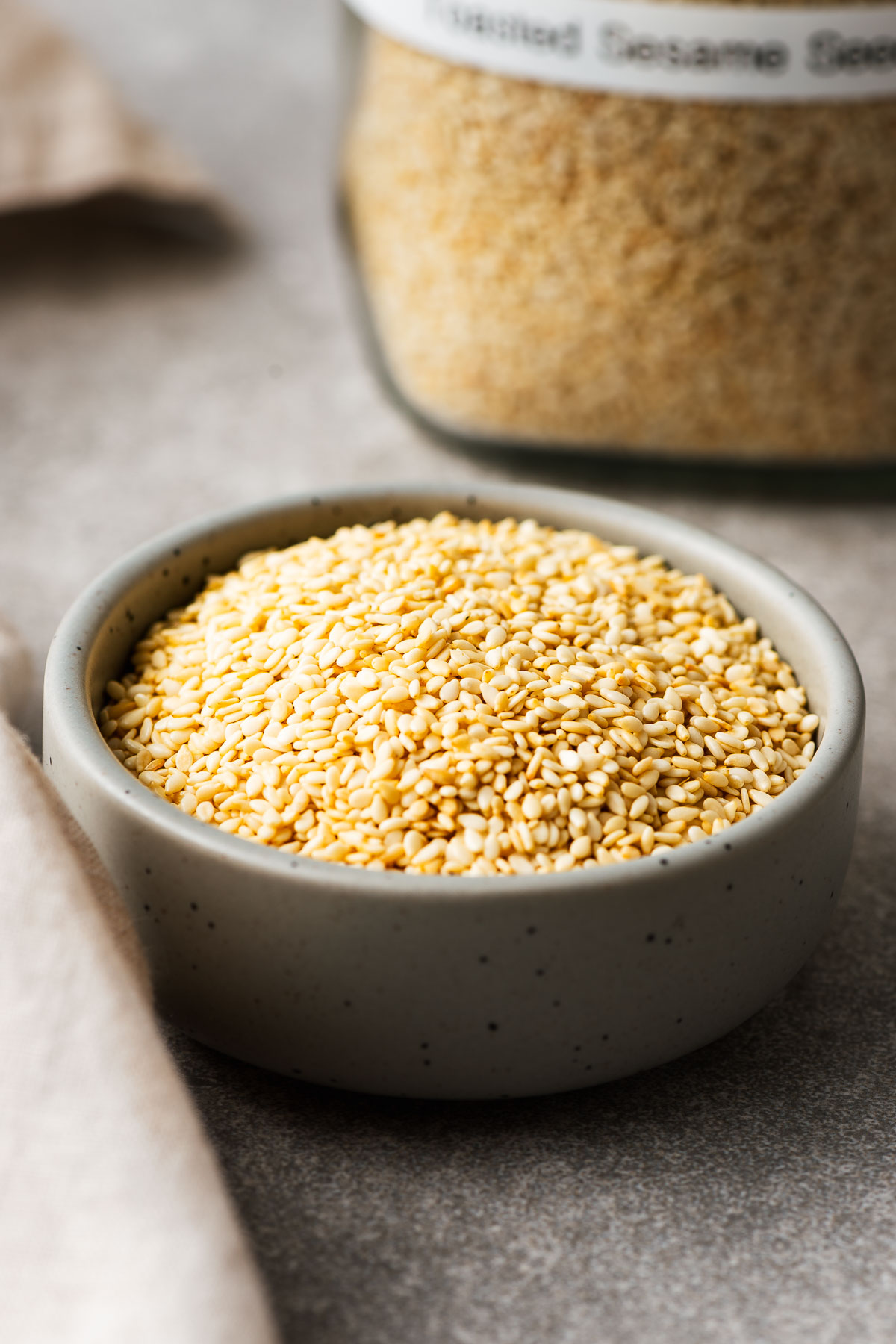
In this post:
- Why you’ll love toasted sesame seeds
- Sesame seeds
- How to roast sesame seeds in the oven (with step-by-step images)
- How to toast sesame seeds on the stove (with step-by-step images)
- Comparison of the two methods
- How to use toasted sesame seeds
- Frequently asked questions
- Toasted sesame seeds recipe card
Why you’ll love toasted sesame seeds
While you can buy pre-roasted sesame seeds in Asian grocery stores, it’s so super easy to toast your own sesame seeds at home, that there’s no reason not to give it a try!
- Toasting enhances the flavour: Roasting sesame seeds intensifies their nutty taste. Whether you’re adding them to a stir fry or sprinkling them over a salad, toasted sesame seeds will add a delicious depth of flavour.
- It adds a delightful crunch: The toasting process also gives sesame seeds a lovely crunch, making them a perfect topping for dishes like baked goods, stir-fries, and salads.
- It’s easy and versatile: You can toast sesame seeds in two ways, on the stovetop or in the oven, making it convenient for any kitchen setup. And, once toasted, they can be stored in a sealed container for up to three months, ready to be used whenever needed.

Sesame seeds
I use raw, hulled white sesame seeds. Hulled sesame seeds are sesame seeds that have had their outer layer, or hull, removed during the manufacturing process. These tiny seeds are the conventional or regular sesame seeds you find in grocery stores.
But, you can also roast unhulled sesame seeds and black sesame seeds. With black sesame seeds, you will have to rely on smell because their colour won’t change to golden brown when they’re done.
How to roast sesame seeds in the oven


Step 1: Preheat your oven to 350°F (180°C). Spread one to two cups of raw sesame seeds in a single layer on a large baking sheet. I don’t line my sheet pan with parchment paper, but you can if yours is looking a bit grim.
You can add more, but the toasting process will take longer if you have a thick layer of raw seeds. It takes roughly 25 minutes to roast three cups of sesame seeds in a half-sheet pan until golden brown.
Step 2: Place the baking sheet on the middle rack of the pre-heated oven. Bake the sesame seeds for eight to ten minutes. Use a wooden spoon to stir every three minutes or so.
Keep an eye on the roasting sesame seeds, as they can burn quickly — and burnt sesame seeds have an undesirable bitter taste. But, stirring occasionally will ensure perfectly even roasting.

Step 3: Remove the sheet pan from the oven. Transfer the toasted sesame seeds to a plate and spread out to cool completely.
How to toast sesame seeds on the stove
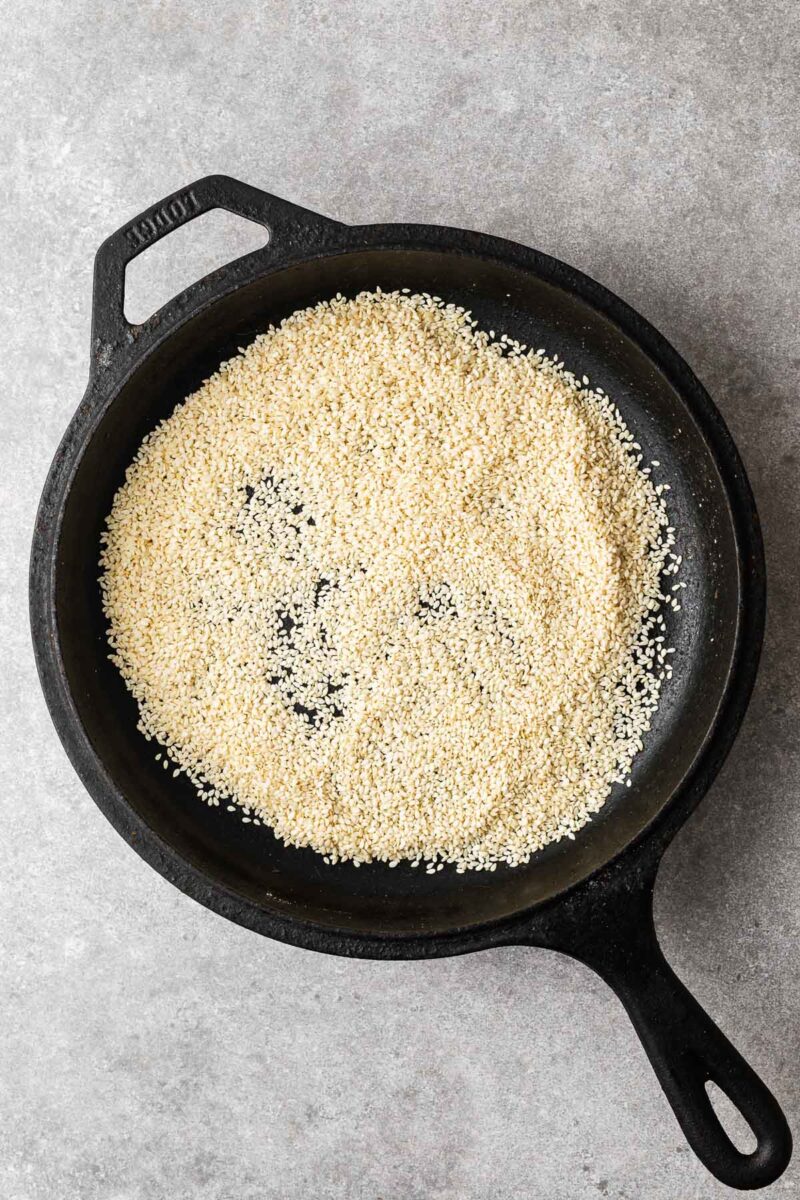

Step 1: Heat a dry skillet or frying pan over medium heat. Add up to half a cup of sesame seeds to the pan.
Step 2: Cook for three to five minutes until the sesame seeds turn golden brown, stirring frequently to ensure even toasting.

Step 3: Transfer the roasted seeds to a plate (otherwise the residual heat from the pan may burn them) and spread them out to cool to room temperature.
Best method for roasting sesame seeds
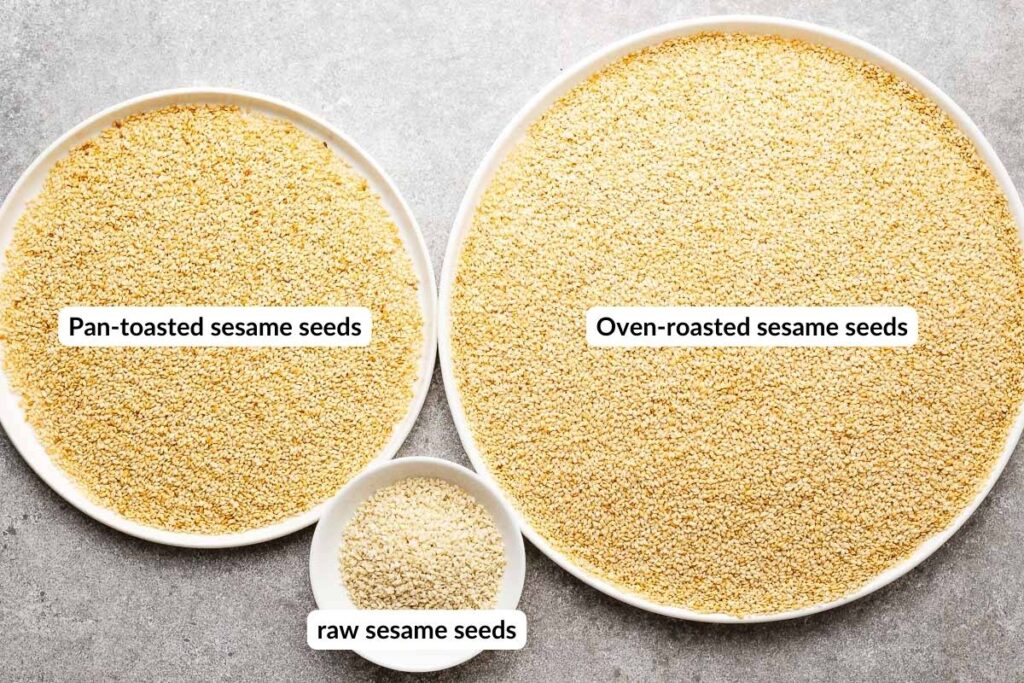
Now that I’ve given you two easy methods for roasting sesame seeds, you might be wondering which is the best method for you.
Toasting sesame seeds in a dry skillet or saute pan allows you to stand close to the toasting seeds as you stir them. This helps to prevent burning, which is great. But the downside of stovetop toasting is that they don’t toast as evenly as the oven, and you can only toast up to half a cup of sesame seeds at a time.
Using the oven method for roasting sesame seeds results in evenly toasted sesame seeds. It’s also more hands-off, which is great. But, because you’re not constantly stirring, you really need to keep a close eye on them to prevent burning. The upside is that you can roast large amounts of sesame seeds a a time.
So, the pan-toasting method is great for you if you only want to roast a small amount of sesame seeds. But, the oven-roasting method delivers the best results for an even toast and works well for large amounts.
Storing roasted sesame seeds
First, allow your golden brown sesame seeds to cool completely.
Then, transfer the roasted seeds to an airtight container. Store it in a cool dark place for up to three months.
You can also freeze the toasted seeds in a freezer bag or freezer-safe container for up to a year.
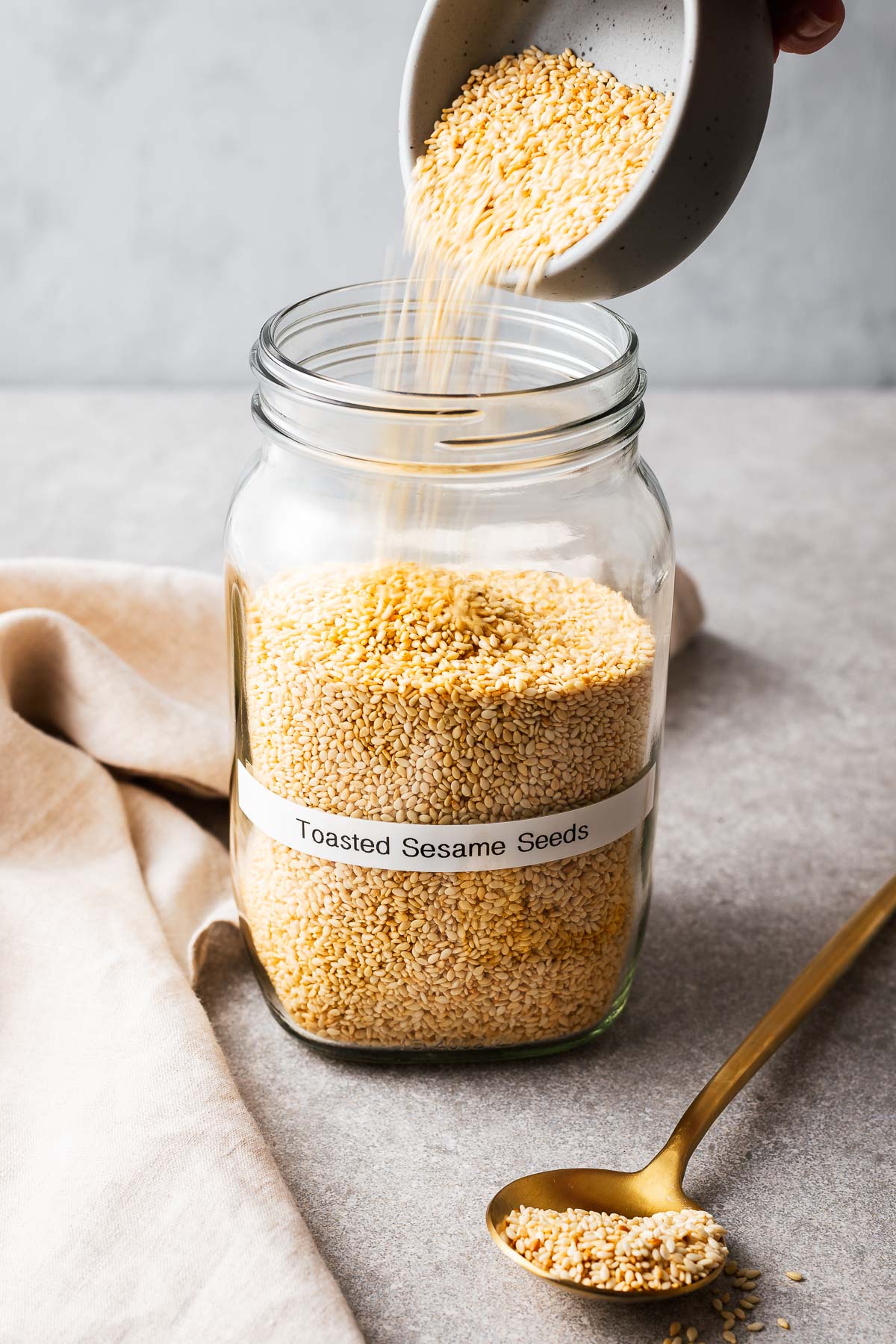
How to use toasted sesame seeds
Toasted sesame seeds are a popular ingredient in many Asian dishes whether they’re store-bought or homemade. But they’re also great sprinkled on anything from boiled eggs to sushi rolls and noodles.
- Sprinkle on salads: Add a sprinkle of toasted sesame seeds to your salads for an extra burst of nutty flavour and crunchy texture. They complement a variety of salad ingredients, I especially love them in Korean sesame broccoli salad.
- Garnish soups and noodles: Top your soups, ramen, or noodle dishes with toasted sesame seeds for a finishing touch. The seeds not only provide visual appeal but also contribute a rich, nutty flavour. I always sprinkle toasted sesame seeds on my favourite Korean gochujang noodles. Or use them to enhance Japanese dishes and noodle soups like this easy kake udon or miso eggplant.
- Upgrade your stir-fry: Toasted sesame seeds are a staple in Asian stir-fry recipes. Sprinkle them over stir-fried vegetables, tofu, or meat dishes to enhance the flavour profile and add a delightful crunch. Try it sprinkled over gochujang tofu.
- Savoury rice bowls: Mix toasted sesame seeds into cooked rice (or other grains like quinoa, bulgur wheat, or couscous) for an extra layer of flavour. I always add a generous sprinkle of toasted sesame seeds to gyeran bap (Korean egg and rice bowls).
- Baking and desserts: Incorporate toasted sesame seeds into baked goods and desserts for a unique twist. Add them to bread dough, cookies, or granola recipes to impart a nutty flavour and a crunchy texture. You can also sprinkle them over desserts like cakes, cupcakes, or ice cream for a decorative touch. Try sesame granola for an interesting twist on a classic
- Homemade sauces and dressings: Toasted sesame seeds can be ground into a paste using a food processor – see how to make tahini – and used as a base for homemade sauces and dressings. Try it in Japanese sesame sauce, miso tahini salad dressing, or this dipping sauce for soba noodles.
With their versatile nature and delicious flavour, toasted sesame seeds are a must-have ingredient in any kitchen. So go ahead, sprinkle, garnish, and savour the delightful taste of toasted sesame seeds in your favourite recipes!
What are your favourite ways to use toasted sesame seeds? Share your tips and ideas in the comments below!
Frequently asked questions
There are two easy toasting methods. For less than half a cup of sesame seeds, toast sesame seeds in a dry pan over medium heat, stirring constantly until golden brown and fragrant. For a large amount of sesame seeds, roast the seeds in a sheet pan at 350 °F for eight to ten minutes. This method allows even cooking, but keep a close eye on them to prevent burning.
Yes, it is recommended to toast sesame seeds in a dry pan over medium heat. You can also use a toaster oven or oven, but be sure to keep a close eye on them as they can burn quickly.
Toasting black sesame seeds is not required, but it enhances their natural nutty flavour and adds a slight crunch. I always recommend toasting white or black sesame seeds when using them as a topping.
No, you do not need any oil to toast sesame seeds. The high oil content of sesame seeds allows them to toast evenly in a dry pan or sheet pan.
Recipes using toasted sesame seeds
- Gyeran bap (Korean egg and rice bowl)
- Gochujang tofu (Korean braised tofu)
- Gochujang noodles (spicy Korean udon noodles)
- Silken tofu with spicy soy dressing
- Korean green onion salad
- Gamja jorim (Korean soy sauce braised potatoes)
- Miso tahini dressing
- Japanese sesame sauce
- Cold soba noodles with dipping sauce

Ingredients
- ½ cup raw sesame seeds*
Instructions
Oven Method: Ideal for large batches
- Preheat your oven to 350 °F.
- Spread the sesame seeds on a large baking sheet in a single layer.
- Place it on the middle rack of the oven. Bake until the sesame seeds are golden brown, removing the baking sheet every 3 minutes to stir. A cup of sesame seeds takes approximately 8-10 minutes to toast in a half-sheet pan.
- Remove the baking sheet from the oven, and transfer the roasted sesame seeds to a plate. Spread them out evenly and allow the roasted sesame seeds to cool to room temperature.
Stovetop Method: Ideal for small batches
- Heat a dry skillet or frying pan over medium heat.
- Add the sesame seeds to the pan and stir frequently using a wooden spoon. (Don’t add more than ½ cup of seeds to the pan – use the oven method instead.)
- Cook for 3-5 minutes, until the sesame seeds have a golden brown colour.
- Transfer the toasted sesame seeds onto a plate and spread out to cool down.
Notes
- I use hulled white sesame seeds (regular sesame seeds), but black sesame seeds and unhulled sesame seeds also benefit from being roasted.
- The stovetop method is ideal for small batches of sesame seeds. To toast a cup (or more) of sesame seeds at a time, use the oven method. See which method is best for you.
- Don’t stray far from the oven (or stove) when toasting sesame seeds. They turn from gorgeous and golden to burnt and bitter in an instant.
- Store toasted sesame seeds in an airtight container in a dark place for up to 3 months. You can also freeze them for up to a year.


